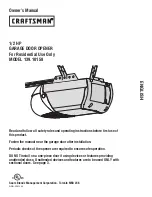
11
FIGURE 17
***
STEP 7
CONTINUED***
See Figure 17
CONNECTING WIRES TO POWER HEAD
Route
wiring through clip on bottom of photo eye holder, then run wires along wall and ceiling to power head
chassis. Use provided staples to fasten wiring to wall, joists and/or ceiling. Do not pinch wiring.
NOTE: As an alternative, the wiring can be routed along the top of the rail assembly, or along the outside of the
garage door track. Be sure the wiring is routed away from all moving parts of door and rail assembly.
Open
the control panel cover by slightly pulling on the cutout, allowing the cover to hang open. To remove, pull firmly
on the cover corner near one of the hinges. Do not twist cover or hinges may break. See Figure 23
Route
wires through wire guide at top of power head chassis into terminal area of control panel. Separate
the dbl.
wire from each photo eye into two single wires: 1) the white wire and 2) the black striped wire. See Figure 17
Remove
about 1/2" (13) of insulation from the end of each of the four single wires. Twist the white
wire ends together and twist the black striped wire ends together. Insert twisted white wire ends
firmly into terminal hole #1 by pushing directly into hole. If wires are difficult to insert, a screwdriver
may be used to depress the terminal tab while inserting the wires. To remove wiring, depress terminal
tab again and pull wiring out. Repeat procedure for the twisted black striped wire ends, except insert
them into terminal hole #2.
STEP 8
WALL CONTROL / PUSH BUTTON
The wall control/push button will allow you to control your garage door from inside the garage. It
must be mounted within sight of the garage door, clear of all moving garage door parts or any
associated parts, at least 5’ (1520) above the floor, out of children's reach. The wall control/push
button should only be used when the door area is free of people or any obstructions.
FASTENING THE WALL CONTROL:
Attach
wiring to back of wall control. White wire end attaches to terminal #3 screw, black striped wire end
attaches to terminal #4 screw.
Locate
where top mounting screw will go. Mark location on wall. Drill 1/16" (1.5) pilot hole into wall.
Fasten top screw into wall with screw head out from wall about 1/8” (3). Fasten wall control into top
slot hole by pushing down firmly onto screw head. For drywall, concrete, etc., drill 3/16” (5) pilot hole for
anchors. See Figure 18
Mark
and drill 1/16"(1.5) pilot hole through bottom screw hole. Insert screw through bottom hole from the front,
and tighten screw. Route wiring from behind through one of the recessed cutouts. Avoid pinching the wires.
CONNECTING WIRES:
Route
wiring through cutout, along wall and ceiling, to opener power head chassis. Use provided staples to secure
wiring. Do not pinch wiring.
Route
wiring through wire guide of chassis to terminal area of control panel. See Figure 17
Remove
about 1/2" (13) of insulation from the end of each wire. Insert white wire end firmly into terminal hole #3.
Insert black striped wire end into terminal #4. To remove wiring, depress tab and pull out wiring. Multiple wall
controls may be installed, parallel or series, if wires are properly connected to terminals 3 and 4 as explained.
S
UT
TR
COPYRIGHT © 2002 MARTIN DOOR
PHOTO EYE
WIRING
RAIL ASSEMBLY
WIRE
GUIDE
TERMINAL
AREA
CONTROL PANEL
WIRE
GUIDE
POWER HEAD
CHASSIS
TERMINAL
HOLES
TERMINAL TABS
TERMINAL
NUMBERS
FIGURE 18
SCREW
HEAD
TOP
SLOT
HOLE
WALL CONTROL
SCREW
WHITE
WIRE
BLACK
STRIPED
WIRE
BOTTOM
SCREW
HOLE
POWER HEAD
M
T
AR IN
M
T
AR IN
FIGURE 17 - CLOSE-UP
PUSH
BUTTON










































